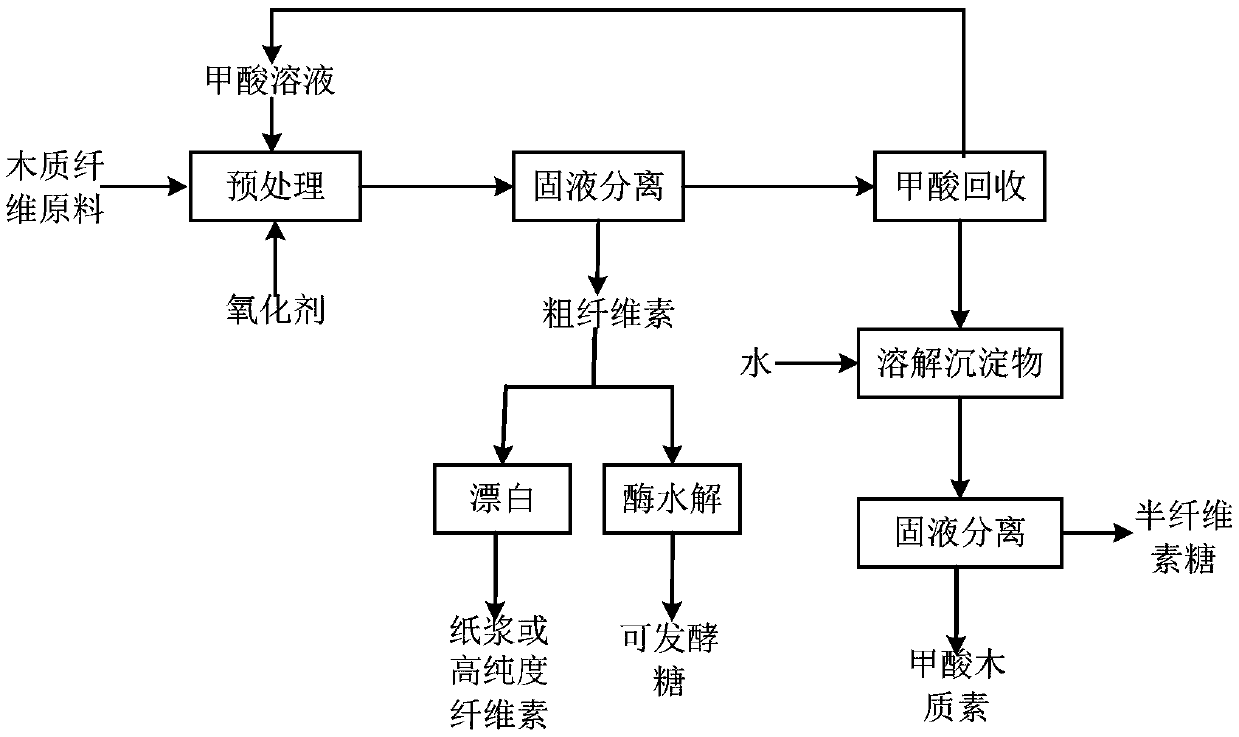Efficient method for separating lignocellulosic raw material
A technology for lignocellulosic raw materials and separation methods, which is applied in the processing of fibrous raw materials, textiles and papermaking, etc., can solve the problems of difficult separation and recovery of lignin and carbohydrates, product quality of catalyst residues, and difficulty in commercialization, and achieve economical realization. The effect of improving the recovery rate is good
- Summary
- Abstract
- Description
- Claims
- Application Information
AI Technical Summary
Problems solved by technology
Method used
Image
Examples
Embodiment 1
[0037] Use a pulverizer to crush the air-dried coniferous wood chips into fine particles with a particle size of about 2mm, and mix them with 88% formic acid aqueous solution and 2wt% green oxygen (relative to the absolute dry raw material) at a liquid-solid ratio of 10:1. The mixture was heated at 140° C. for 30 min in an autoclave (Parr 4848, 300 mL). After reaching the specified reaction time, cool to room temperature, and filter to obtain the crude cellulose solid part and the formic acid solution part in which hemicellulose sugar and lignin are dissolved.
[0038] Distill the liquid part under reduced pressure to recover formic acid, add deionized water about 8 times the volume of the precipitate to the remaining precipitate after distillation, mix well and then centrifuge, the supernatant liquid is hemicellulose sugar, and the precipitate part is formic acid lignin. The content of cellulose, hemicellulose and lignin was then analyzed according to the method described in ...
Embodiment 2
[0042] Use a pulverizer to crush the air-dried coniferous wood chips into fine particles with a particle size of about 2 mm, and mix them with 88% formic acid aqueous solution and 10 wt% hydrogen peroxide (relative to the dry raw material) at a liquid-solid ratio of 10:1. Into an autoclave (Parr 4848, 300 mL), the mixture was heated at 140 °C for 30 min. After reaching the specified reaction time, cool to room temperature, and filter to obtain the crude cellulose solid part and the formic acid solution part in which hemicellulose sugar and lignin are dissolved.
[0043] Distill the liquid part under reduced pressure to recover formic acid, add deionized water about 8 times the volume of the precipitate to the remaining precipitate after distillation, mix well and then centrifuge, the supernatant liquid is hemicellulose sugar, and the precipitate part is formic acid lignin.
[0044] The obtained crude cellulose solid part is beaten with water until the solid concentration is 10...
Embodiment 3
[0049] The air-dried coniferous wood chips were crushed into fine particles with a particle size of about 2mm with a pulverizer, mixed with an aqueous formic acid solution with a concentration of 88% at a liquid-to-solid ratio of 10:1, and added to an autoclave (Parr4848, 300mL), and then added to the high-pressure reactor. Oxygen gas at a pressure of 0.6 MP was introduced into the reactor, and then the mixture was heated at 130° C. for 30 min. After reaching the specified reaction time, cool to room temperature, and filter to obtain the crude cellulose solid part and the formic acid solution part in which hemicellulose sugar and lignin are dissolved.
[0050] Distill the liquid part under reduced pressure to recover formic acid, add deionized water about 8 times the volume of the precipitate to the remaining precipitate after distillation, mix well and then centrifuge, the supernatant liquid is hemicellulose sugar, and the precipitate part is formic acid lignin.
[0051] The ...
PUM
| Property | Measurement | Unit |
|---|---|---|
| particle diameter | aaaaa | aaaaa |
Abstract
Description
Claims
Application Information
 Login to View More
Login to View More - R&D
- Intellectual Property
- Life Sciences
- Materials
- Tech Scout
- Unparalleled Data Quality
- Higher Quality Content
- 60% Fewer Hallucinations
Browse by: Latest US Patents, China's latest patents, Technical Efficacy Thesaurus, Application Domain, Technology Topic, Popular Technical Reports.
© 2025 PatSnap. All rights reserved.Legal|Privacy policy|Modern Slavery Act Transparency Statement|Sitemap|About US| Contact US: help@patsnap.com

